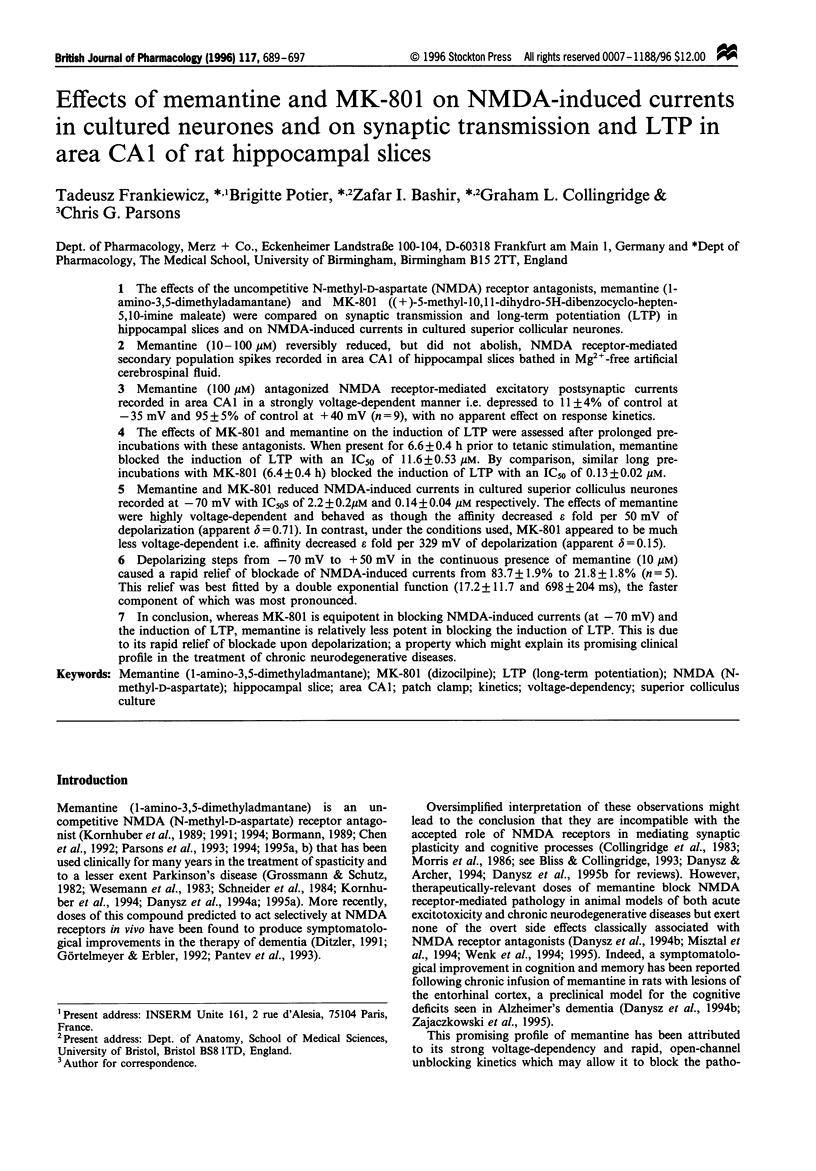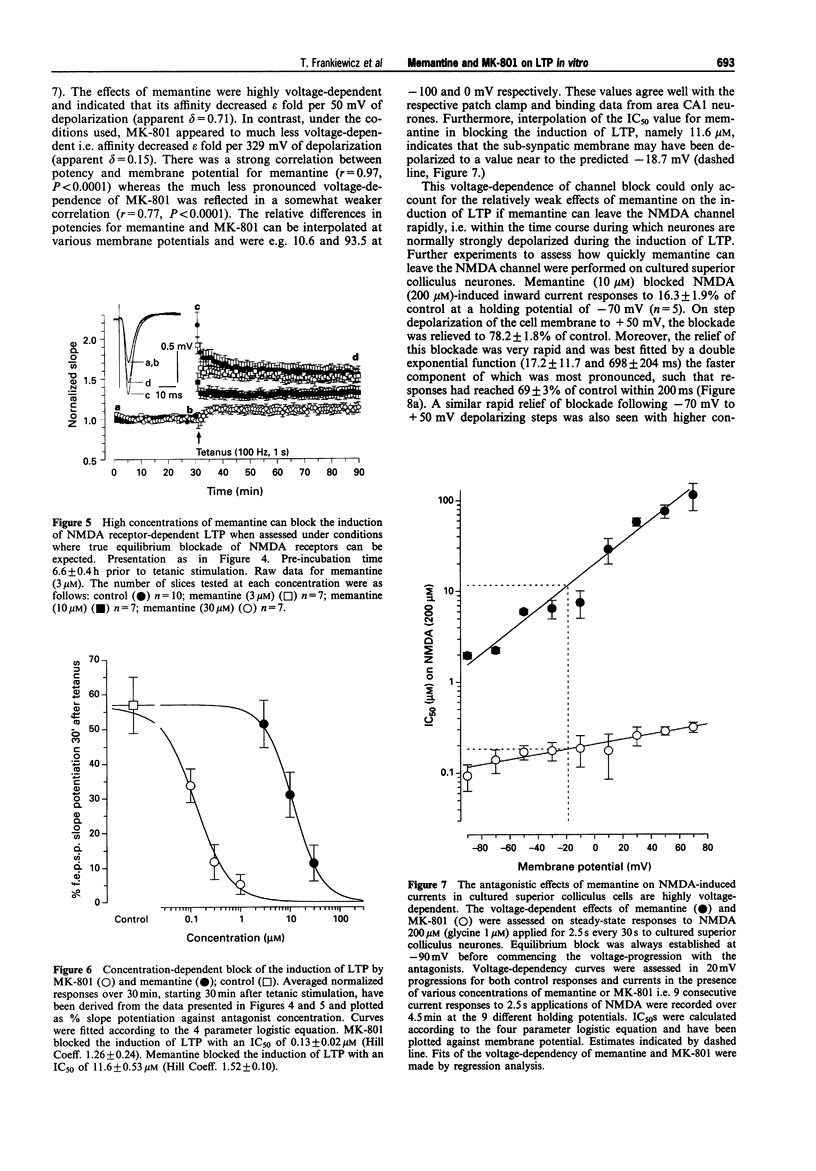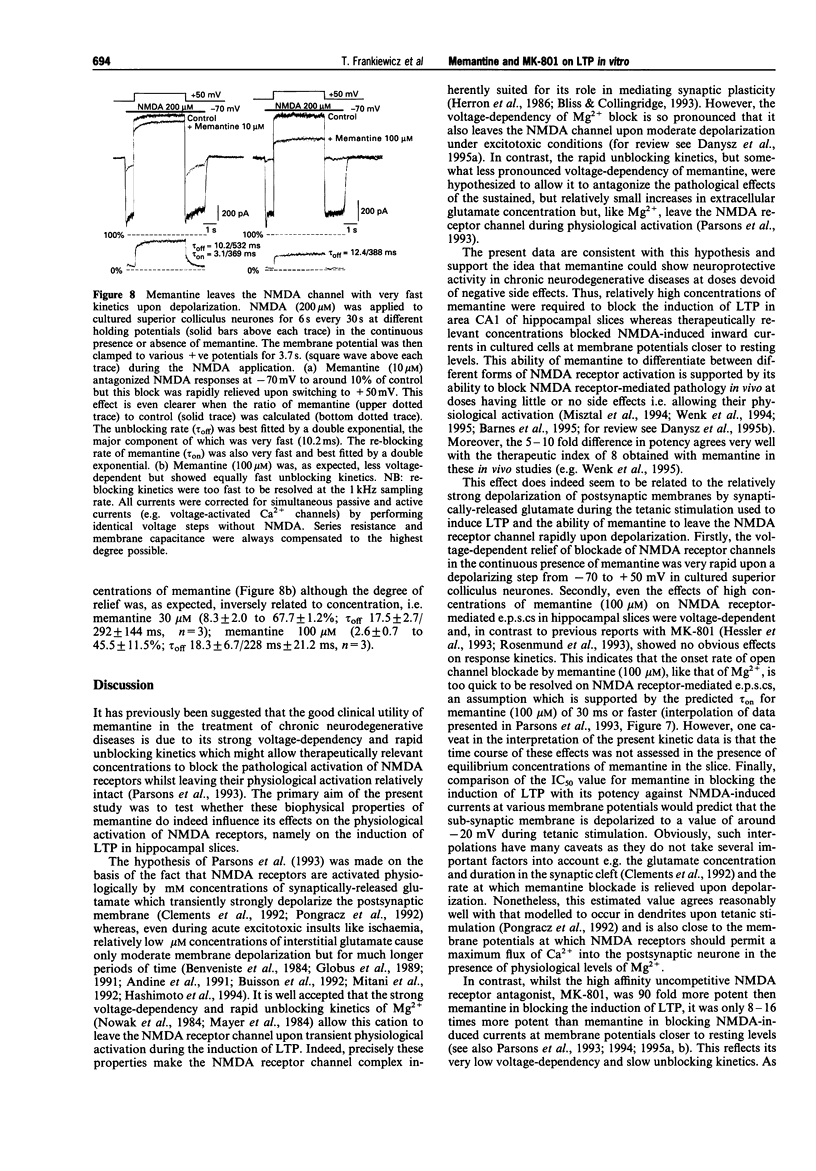Abstract
The effects of the uncompetitive N-methyl-D-aspartate (NMDA) receptor antagonists, memantine (1-amino-3,5-dimethyladamantane) and MK-801 ((+)-5-methyl-10,11-dihydro-5H-dibenzocyclo-hepten-5,10-imin e maleate) were compared on synaptic transmission and long-term potentiation (LTP) in hippocampal slices and on NMDA-induced currents in cultured superior collicular neurones. 2. Memantine (10-100 microM) reversibly reduced, but did not abolish, NMDA receptor-mediated secondary population spikes recorded in area CA1 of hippocampal slices bathed in Mg(2+)-free artificial cerebrospinal fluid. 3. Memantine (100 microM) antagonized NMDA receptor-mediated excitatory postsynaptic currents recorded in area CA1 in a strongly voltage-dependent manner i.e. depressed to 11 +/- 4% of control at -35 mV and 95 +/- 5% of control at +40 mV (n = 9), with no apparent effect on response kinetics. 4. The effects of MK-801 and memantine on the induction of LTP were assessed after prolonged pre-incubations with these antagonists. When present for 6.6 +/- 0.4 h prior to tetanic stimulation, memantine blocked the induction of LTP with an IC50 of 11.6 +/- 0.53 microM. By comparison, similar long pre-incubations with MK-801 (6.4 +/- 0.4 h) blocked the induction of LTP with an IC50 of 0.13 +/- 0.02 microM. 5. Memantine and MK-801 reduced NMDA-induced currents in cultured superior colliculus neurones recorded at -70 mV with IC50s of 2.2 +/- 0.2 microM and 0.14 +/- 0.04 microM respectively. The effects of memantine were highly voltage-dependent and behaved as though the affinity decreased epsilon fold per 50 mV of depolarization (apparent delta = 0.71). In contrast, under the conditions used, MK-801 appeared to be much less voltage-dependent i.e. affinity decreased epsilon fold per 329 mV of depolarization (apparent delta = 0.15). 6. Depolarizing steps from -70 mV to +50 mV in the continuous presence of memantine (10 microM) caused a rapid relief of blockade of NMDA-induced currents from 83.7 +/- 1.9% to 21.8 +/- 1.8% (n = 5). This relief was best fitted by a double exponential function (17.2 +/- 11.7 and 698 +/- 204 ms), the faster component of which was most pronounced. 7. In conclusion, whereas MK-801 is equipotent in blocking NMDA-induced currents (at - 70 mV) and the induction of LTP, memantine is relatively less potent in blocking the induction of LTP. This is due to its rapid relief of blockade upon depolarization; a property which might explain its promising clinical profile in the treatment of chronic neurodegenerative diseases.
Full text
PDF








Selected References
These references are in PubMed. This may not be the complete list of references from this article.
- Andiné P., Sandberg M., Bågenholm R., Lehmann A., Hagberg H. Intra- and extracellular changes of amino acids in the cerebral cortex of the neonatal rat during hypoxic-ischemia. Brain Res Dev Brain Res. 1991 Dec 17;64(1-2):115–120. doi: 10.1016/0165-3806(91)90214-4. [DOI] [PubMed] [Google Scholar]
- Apland J. P., Cann F. J. Anticonvulsant effects of memantine and MK-801 in guinea pig hippocampal slices. Brain Res Bull. 1995;37(3):311–316. doi: 10.1016/0361-9230(95)00038-g. [DOI] [PubMed] [Google Scholar]
- Bashir Zafar I., Collingridge Graham L. NMDA Receptor-dependent Transient Homo- and Heterosynaptic Depression in Picrotoxin-treated Hippocampal Slices. Eur J Neurosci. 1992;4(6):485–490. doi: 10.1111/j.1460-9568.1992.tb00898.x. [DOI] [PubMed] [Google Scholar]
- Benveniste H., Drejer J., Schousboe A., Diemer N. H. Elevation of the extracellular concentrations of glutamate and aspartate in rat hippocampus during transient cerebral ischemia monitored by intracerebral microdialysis. J Neurochem. 1984 Nov;43(5):1369–1374. doi: 10.1111/j.1471-4159.1984.tb05396.x. [DOI] [PubMed] [Google Scholar]
- Bliss T. V., Collingridge G. L. A synaptic model of memory: long-term potentiation in the hippocampus. Nature. 1993 Jan 7;361(6407):31–39. doi: 10.1038/361031a0. [DOI] [PubMed] [Google Scholar]
- Bormann J. Memantine is a potent blocker of N-methyl-D-aspartate (NMDA) receptor channels. Eur J Pharmacol. 1989 Aug 3;166(3):591–592. doi: 10.1016/0014-2999(89)90385-3. [DOI] [PubMed] [Google Scholar]
- Boulton C. L., Irving A. J., Southam E., Potier B., Garthwaite J., Collingridge G. L. The nitric oxide--cyclic GMP pathway and synaptic depression in rat hippocampal slices. Eur J Neurosci. 1994 Oct 1;6(10):1528–1535. doi: 10.1111/j.1460-9568.1994.tb00543.x. [DOI] [PubMed] [Google Scholar]
- Bresink I., Danysz W., Parsons C. G., Mutschler E. Different binding affinities of NMDA receptor channel blockers in various brain regions--indication of NMDA receptor heterogeneity. Neuropharmacology. 1995 May;34(5):533–540. doi: 10.1016/0028-3908(95)00017-z. [DOI] [PubMed] [Google Scholar]
- Buisson A., Callebert J., Mathieu E., Plotkine M., Boulu R. G. Striatal protection induced by lesioning the substantia nigra of rats subjected to focal ischemia. J Neurochem. 1992 Sep;59(3):1153–1157. doi: 10.1111/j.1471-4159.1992.tb08358.x. [DOI] [PubMed] [Google Scholar]
- Chen H. S., Pellegrini J. W., Aggarwal S. K., Lei S. Z., Warach S., Jensen F. E., Lipton S. A. Open-channel block of N-methyl-D-aspartate (NMDA) responses by memantine: therapeutic advantage against NMDA receptor-mediated neurotoxicity. J Neurosci. 1992 Nov;12(11):4427–4436. doi: 10.1523/JNEUROSCI.12-11-04427.1992. [DOI] [PMC free article] [PubMed] [Google Scholar]
- Clements J. D., Lester R. A., Tong G., Jahr C. E., Westbrook G. L. The time course of glutamate in the synaptic cleft. Science. 1992 Nov 27;258(5087):1498–1501. doi: 10.1126/science.1359647. [DOI] [PubMed] [Google Scholar]
- Coan E. J., Collingridge G. L. Characterization of an N-methyl-D-aspartate receptor component of synaptic transmission in rat hippocampal slices. Neuroscience. 1987 Jul;22(1):1–8. doi: 10.1016/0306-4522(87)90192-8. [DOI] [PubMed] [Google Scholar]
- Coan E. J., Collingridge G. L. Effects of phencyclidine, SKF 10,047 and related psychotomimetic agents on N-methyl-D-aspartate receptor mediated synaptic responses in rat hippocampal slices. Br J Pharmacol. 1987 Jul;91(3):547–556. doi: 10.1111/j.1476-5381.1987.tb11248.x. [DOI] [PMC free article] [PubMed] [Google Scholar]
- Coan E. J., Saywood W., Collingridge G. L. MK-801 blocks NMDA receptor-mediated synaptic transmission and long term potentiation in rat hippocampal slices. Neurosci Lett. 1987 Sep 11;80(1):111–114. doi: 10.1016/0304-3940(87)90505-2. [DOI] [PubMed] [Google Scholar]
- Collingridge G. L., Kehl S. J., McLennan H. Excitatory amino acids in synaptic transmission in the Schaffer collateral-commissural pathway of the rat hippocampus. J Physiol. 1983 Jan;334:33–46. doi: 10.1113/jphysiol.1983.sp014478. [DOI] [PMC free article] [PubMed] [Google Scholar]
- Danysz W., Gossel M., Zajaczkowski W., Dill D., Quack G. Are NMDA antagonistic properties relevant for antiparkinsonian-like activity in rats?--case of amantadine and memantine. J Neural Transm Park Dis Dement Sect. 1994;7(3):155–166. doi: 10.1007/BF02253435. [DOI] [PubMed] [Google Scholar]
- Danysz W., Zajaczkowski W., Parsons C.G. Modulation of learning processes by ionotropic glutamate receptor ligands. Behav Pharmacol. 1995 Aug;6(5-6):455–474. [PubMed] [Google Scholar]
- Davies S. N., Martin D., Millar J. D., Aram J. A., Church J., Lodge D. Differences in results from in vivo and in vitro studies on the use-dependency of N-methylaspartate antagonism by MK-801 and other phencyclidine receptor ligands. Eur J Pharmacol. 1988 Jan 12;145(2):141–151. doi: 10.1016/0014-2999(88)90225-7. [DOI] [PubMed] [Google Scholar]
- Dimpfel W. Effects of memantine on synaptic transmission in the hippocampus in vitro. Arzneimittelforschung. 1995 Jan;45(1):1–5. [PubMed] [Google Scholar]
- Ditzler K. Efficacy and tolerability of memantine in patients with dementia syndrome. A double-blind, placebo controlled trial. Arzneimittelforschung. 1991 Aug;41(8):773–780. [PubMed] [Google Scholar]
- Globus M. Y., Busto R., Dietrich W. D., Martinez E., Valdes I., Ginsberg M. D. Effect of ischemia on the in vivo release of striatal dopamine, glutamate, and gamma-aminobutyric acid studied by intracerebral microdialysis. J Neurochem. 1988 Nov;51(5):1455–1464. doi: 10.1111/j.1471-4159.1988.tb01111.x. [DOI] [PubMed] [Google Scholar]
- Globus M. Y., Busto R., Martinez E., Valdés I., Dietrich W. D., Ginsberg M. D. Comparative effect of transient global ischemia on extracellular levels of glutamate, glycine, and gamma-aminobutyric acid in vulnerable and nonvulnerable brain regions in the rat. J Neurochem. 1991 Aug;57(2):470–478. doi: 10.1111/j.1471-4159.1991.tb03775.x. [DOI] [PubMed] [Google Scholar]
- Grossmann W., Schütz W. Memantin und neurogene Blasenstörungen im Rahmen spastischer Zustandsbilder. Arzneimittelforschung. 1982;32(10):1273–1276. [PubMed] [Google Scholar]
- Görtelmeyer R., Erbler H. Memantine in the treatment of mild to moderate dementia syndrome. A double-blind placebo-controlled study. Arzneimittelforschung. 1992 Jul;42(7):904–913. [PubMed] [Google Scholar]
- Halliwell R. F., Peters J. A., Lambert J. J. The mechanism of action and pharmacological specificity of the anticonvulsant NMDA antagonist MK-801: a voltage clamp study on neuronal cells in culture. Br J Pharmacol. 1989 Feb;96(2):480–494. doi: 10.1111/j.1476-5381.1989.tb11841.x. [DOI] [PMC free article] [PubMed] [Google Scholar]
- Hashimoto N., Matsumoto T., Mabe H., Hashitani T., Nishino H. Dopamine has inhibitory and accelerating effects on ischemia-induced neuronal cell damage in the rat striatum. Brain Res Bull. 1994;33(3):281–288. doi: 10.1016/0361-9230(94)90195-3. [DOI] [PubMed] [Google Scholar]
- Herron C. E., Lester R. A., Coan E. J., Collingridge G. L. Frequency-dependent involvement of NMDA receptors in the hippocampus: a novel synaptic mechanism. Nature. 1986 Jul 17;322(6076):265–268. doi: 10.1038/322265a0. [DOI] [PubMed] [Google Scholar]
- Hessler N. A., Shirke A. M., Malinow R. The probability of transmitter release at a mammalian central synapse. Nature. 1993 Dec 9;366(6455):569–572. doi: 10.1038/366569a0. [DOI] [PubMed] [Google Scholar]
- Huettner J. E., Bean B. P. Block of N-methyl-D-aspartate-activated current by the anticonvulsant MK-801: selective binding to open channels. Proc Natl Acad Sci U S A. 1988 Feb;85(4):1307–1311. doi: 10.1073/pnas.85.4.1307. [DOI] [PMC free article] [PubMed] [Google Scholar]
- Karschin A., Aizenman E., Lipton S. A. The interaction of agonists and noncompetitive antagonists at the excitatory amino acid receptors in rat retinal ganglion cells in vitro. J Neurosci. 1988 Aug;8(8):2895–2906. doi: 10.1523/JNEUROSCI.08-08-02895.1988. [DOI] [PMC free article] [PubMed] [Google Scholar]
- Kornhuber J., Bormann J., Hübers M., Rusche K., Riederer P. Effects of the 1-amino-adamantanes at the MK-801-binding site of the NMDA-receptor-gated ion channel: a human postmortem brain study. Eur J Pharmacol. 1991 Apr 25;206(4):297–300. doi: 10.1016/0922-4106(91)90113-v. [DOI] [PubMed] [Google Scholar]
- Kornhuber J., Bormann J., Retz W., Hübers M., Riederer P. Memantine displaces [3H]MK-801 at therapeutic concentrations in postmortem human frontal cortex. Eur J Pharmacol. 1989 Aug 3;166(3):589–590. doi: 10.1016/0014-2999(89)90384-1. [DOI] [PubMed] [Google Scholar]
- Kornhuber J., Quack G. Cerebrospinal fluid and serum concentrations of the N-methyl-D-aspartate (NMDA) receptor antagonist memantine in man. Neurosci Lett. 1995 Aug 4;195(2):137–139. doi: 10.1016/0304-3940(95)11785-u. [DOI] [PubMed] [Google Scholar]
- Kornhuber J., Weller M., Schoppmeyer K., Riederer P. Amantadine and memantine are NMDA receptor antagonists with neuroprotective properties. J Neural Transm Suppl. 1994;43:91–104. [PubMed] [Google Scholar]
- MacDonald J. F., Nowak L. M. Mechanisms of blockade of excitatory amino acid receptor channels. Trends Pharmacol Sci. 1990 Apr;11(4):167–172. doi: 10.1016/0165-6147(90)90070-O. [DOI] [PubMed] [Google Scholar]
- Mayer M. L., Westbrook G. L., Guthrie P. B. Voltage-dependent block by Mg2+ of NMDA responses in spinal cord neurones. Nature. 1984 May 17;309(5965):261–263. doi: 10.1038/309261a0. [DOI] [PubMed] [Google Scholar]
- Mitani A., Andou Y., Kataoka K. Selective vulnerability of hippocampal CA1 neurons cannot be explained in terms of an increase in glutamate concentration during ischemia in the gerbil: brain microdialysis study. Neuroscience. 1992;48(2):307–313. doi: 10.1016/0306-4522(92)90492-k. [DOI] [PubMed] [Google Scholar]
- Morris R. G., Anderson E., Lynch G. S., Baudry M. Selective impairment of learning and blockade of long-term potentiation by an N-methyl-D-aspartate receptor antagonist, AP5. 1986 Feb 27-Mar 5Nature. 319(6056):774–776. doi: 10.1038/319774a0. [DOI] [PubMed] [Google Scholar]
- Nowak L., Bregestovski P., Ascher P., Herbet A., Prochiantz A. Magnesium gates glutamate-activated channels in mouse central neurones. Nature. 1984 Feb 2;307(5950):462–465. doi: 10.1038/307462a0. [DOI] [PubMed] [Google Scholar]
- Parsons C. G., Gruner R., Rozental J., Millar J., Lodge D. Patch clamp studies on the kinetics and selectivity of N-methyl-D-aspartate receptor antagonism by memantine (1-amino-3,5-dimethyladamantan). Neuropharmacology. 1993 Dec;32(12):1337–1350. doi: 10.1016/0028-3908(93)90029-3. [DOI] [PubMed] [Google Scholar]
- Parsons C. G., Quack G., Bresink I., Baran L., Przegalinski E., Kostowski W., Krzascik P., Hartmann S., Danysz W. Comparison of the potency, kinetics and voltage-dependency of a series of uncompetitive NMDA receptor antagonists in vitro with anticonvulsive and motor impairment activity in vivo. Neuropharmacology. 1995 Oct;34(10):1239–1258. doi: 10.1016/0028-3908(95)00092-k. [DOI] [PubMed] [Google Scholar]
- Pongrácz F., Poolos N. P., Kocsis J. D., Shepherd G. M. A model of NMDA receptor-mediated activity in dendrites of hippocampal CA1 pyramidal neurons. J Neurophysiol. 1992 Dec;68(6):2248–2259. doi: 10.1152/jn.1992.68.6.2248. [DOI] [PMC free article] [PubMed] [Google Scholar]
- Rosenmund C., Clements J. D., Westbrook G. L. Nonuniform probability of glutamate release at a hippocampal synapse. Science. 1993 Oct 29;262(5134):754–757. doi: 10.1126/science.7901909. [DOI] [PubMed] [Google Scholar]
- Schneider E., Fischer P. A., Clemens R., Balzereit F., Fünfgeld E. W., Haase H. J. Wirkungen oraler Memantin-Gaben auf die Parkinson-Symptomatik. Ergebnisse einer placebo-kontrollierten Multicenter-Studie. Dtsch Med Wochenschr. 1984 Jun 22;109(25):987–990. doi: 10.1055/s-2008-1069311. [DOI] [PubMed] [Google Scholar]
- Wenk G. L., Danysz W., Mobley S. L. Investigations of neurotoxicity and neuroprotection within the nucleus basalis of the rat. Brain Res. 1994 Aug 29;655(1-2):7–11. doi: 10.1016/0006-8993(94)91590-3. [DOI] [PubMed] [Google Scholar]
- Wenk G. L., Danysz W., Mobley S. L. MK-801, memantine and amantadine show neuroprotective activity in the nucleus basalis magnocellularis. Eur J Pharmacol. 1995 Oct 6;293(3):267–270. doi: 10.1016/0926-6917(95)00028-3. [DOI] [PubMed] [Google Scholar]
- Wesemann W., Sontag K. H., Maj J. Zur Pharmakodynamik und Pharmakokinetik des Memantin. Arzneimittelforschung. 1983;33(8):1122–1134. [PubMed] [Google Scholar]
- Wong E. H., Kemp J. A., Priestley T., Knight A. R., Woodruff G. N., Iversen L. L. The anticonvulsant MK-801 is a potent N-methyl-D-aspartate antagonist. Proc Natl Acad Sci U S A. 1986 Sep;83(18):7104–7108. doi: 10.1073/pnas.83.18.7104. [DOI] [PMC free article] [PubMed] [Google Scholar]
- Woodhull A. M. Ionic blockage of sodium channels in nerve. J Gen Physiol. 1973 Jun;61(6):687–708. doi: 10.1085/jgp.61.6.687. [DOI] [PMC free article] [PubMed] [Google Scholar]


